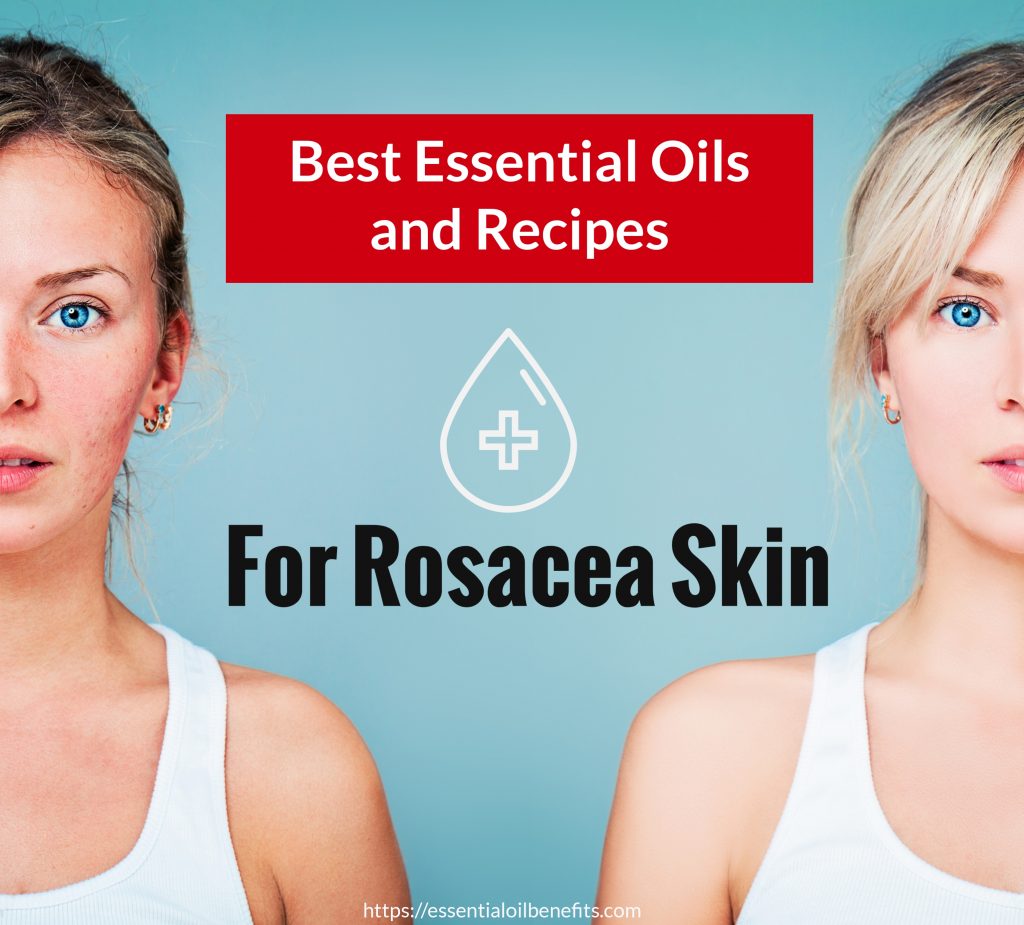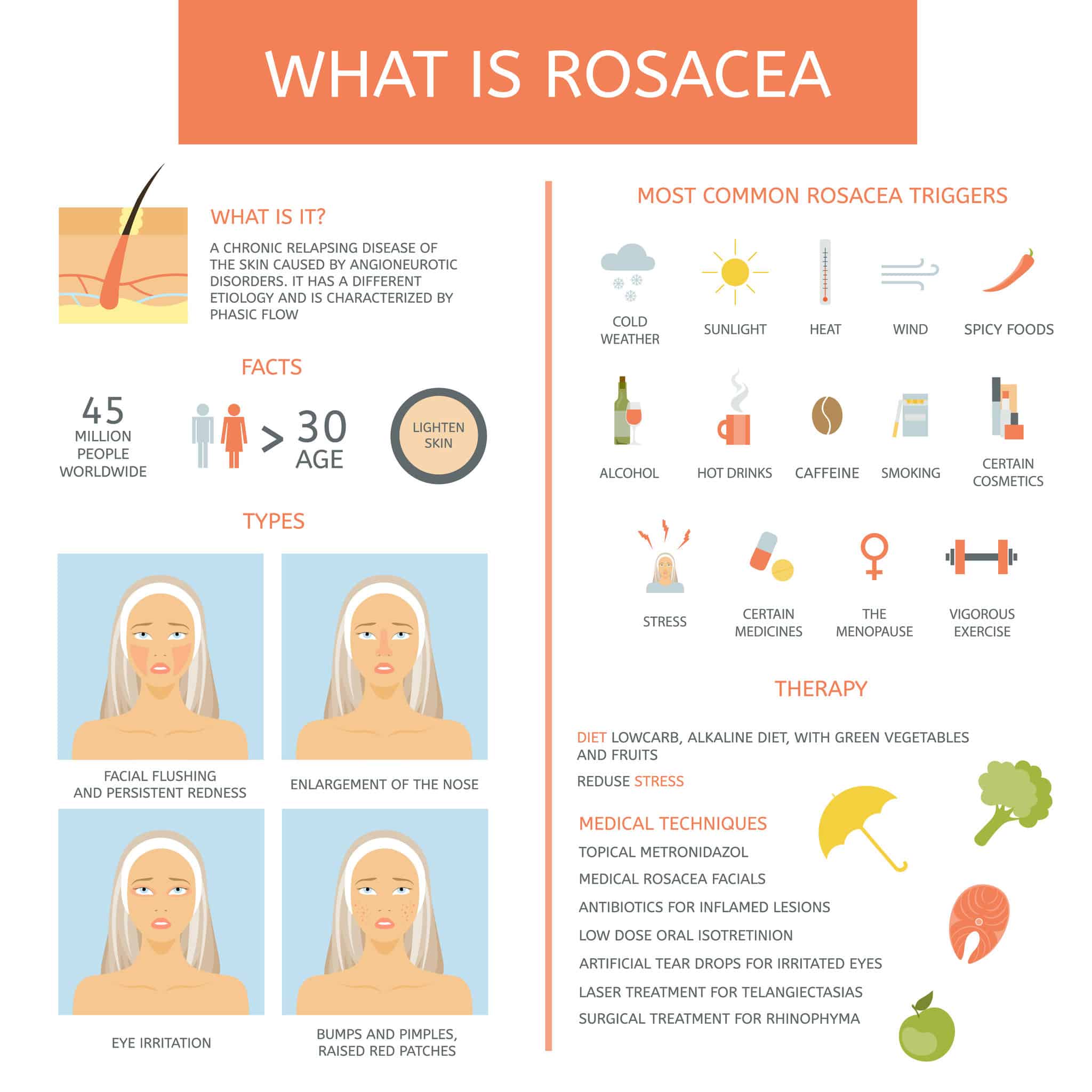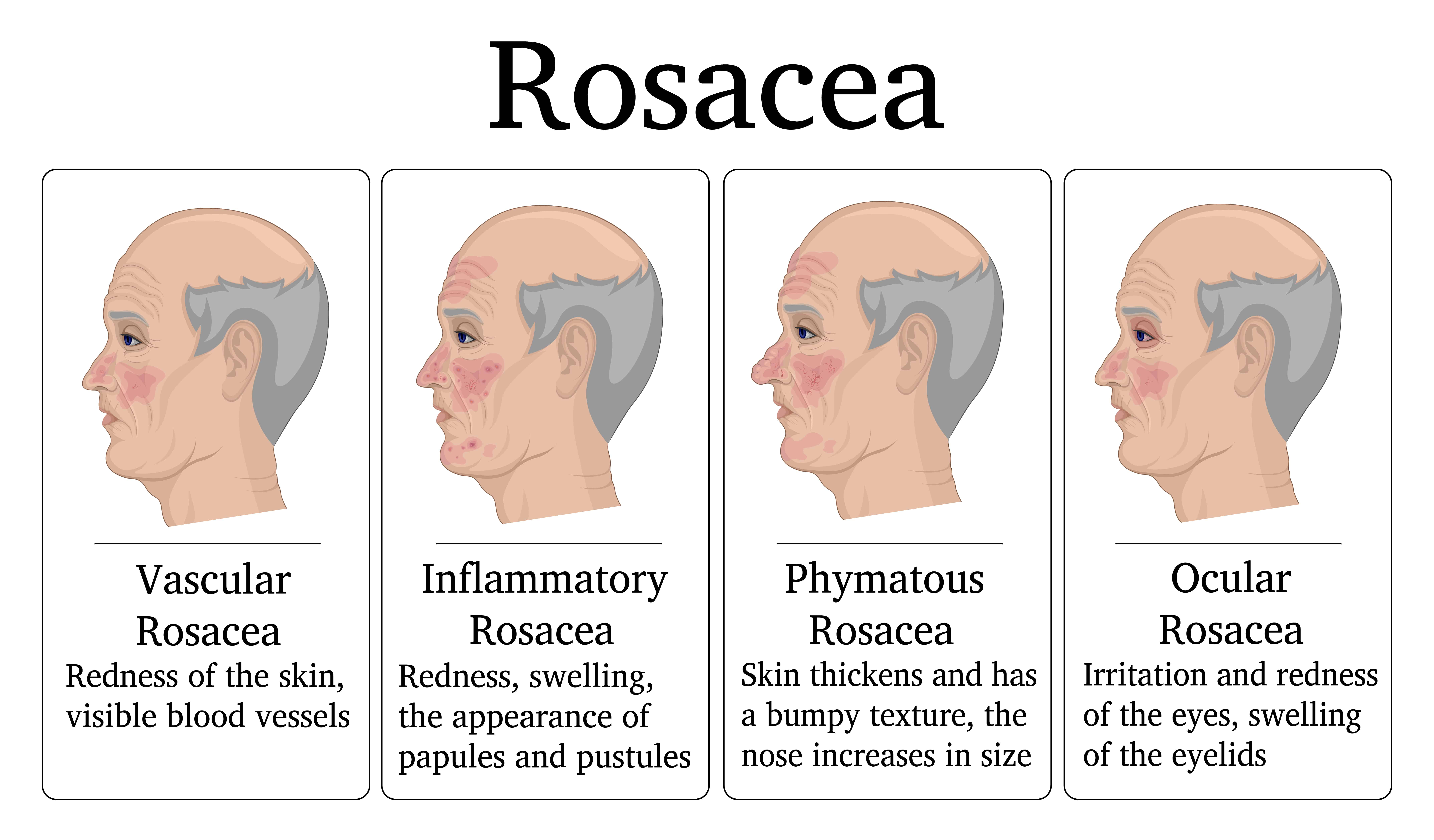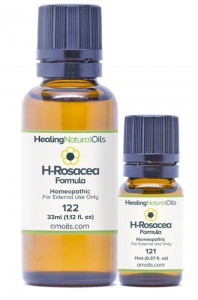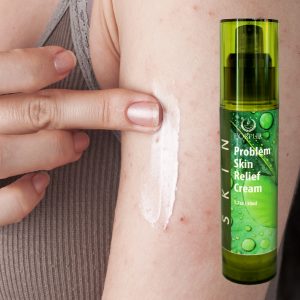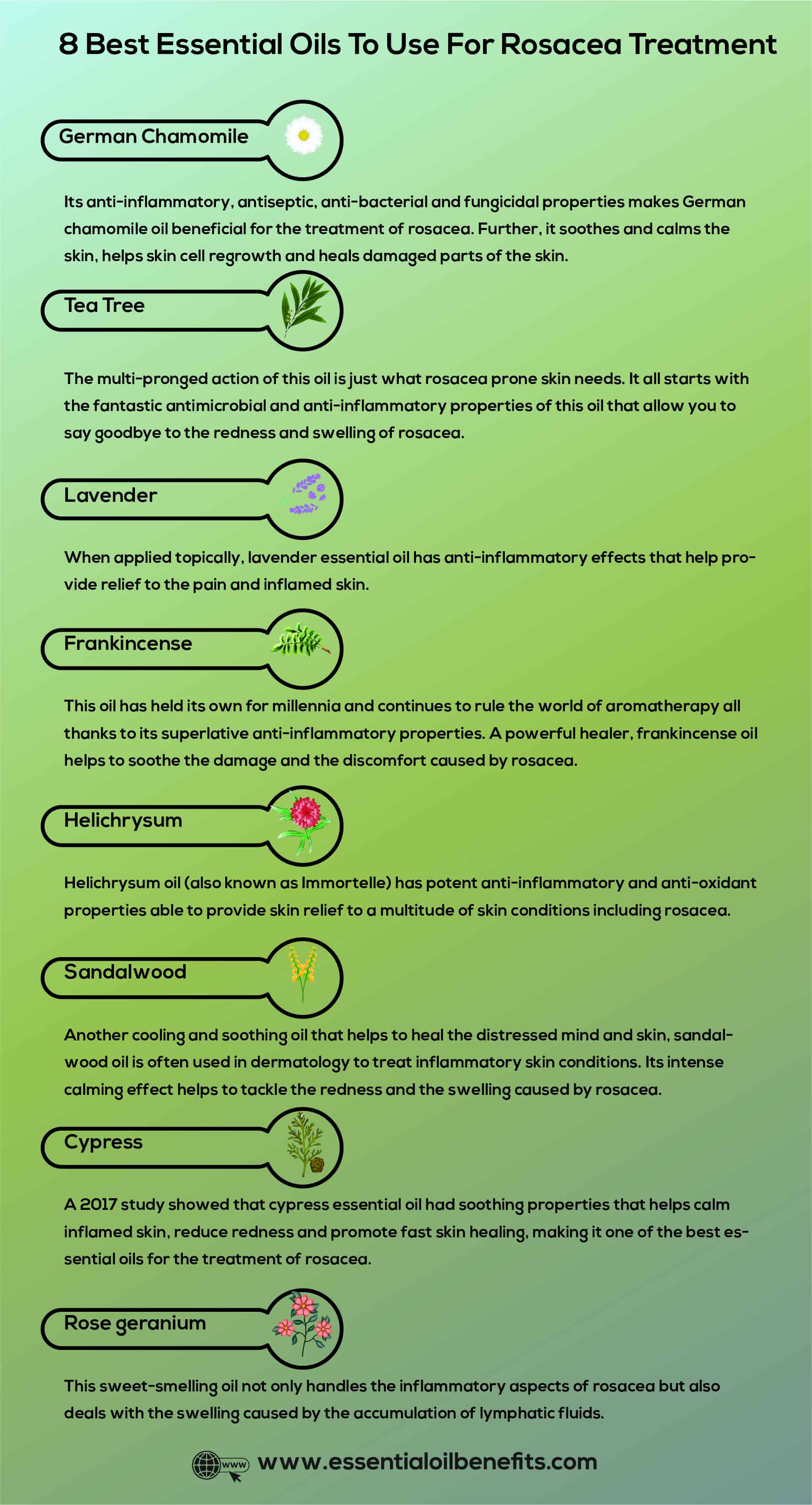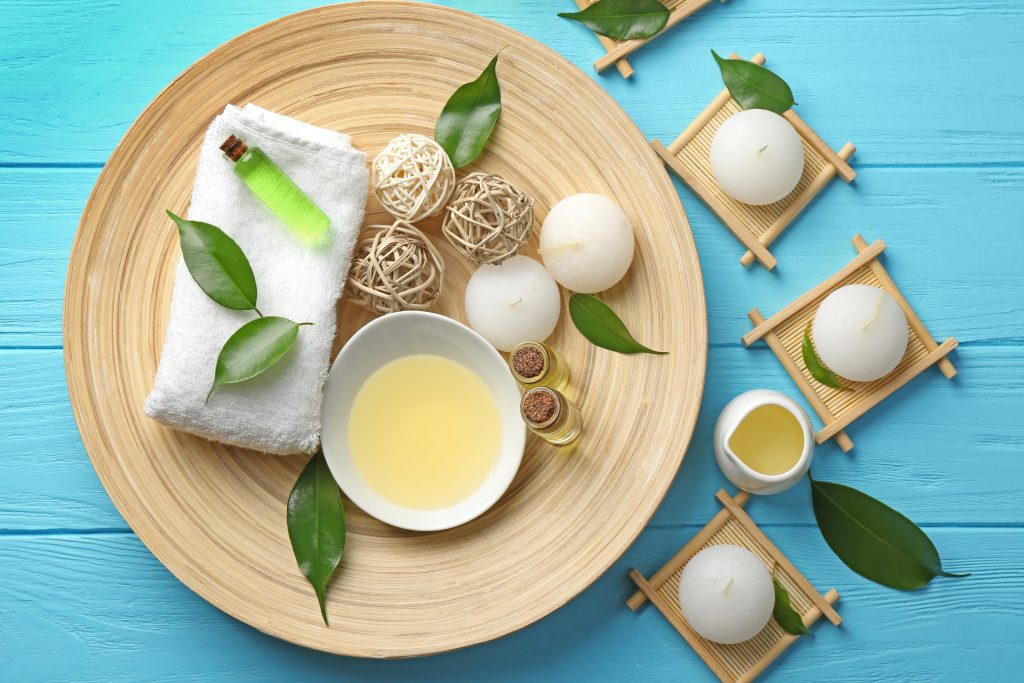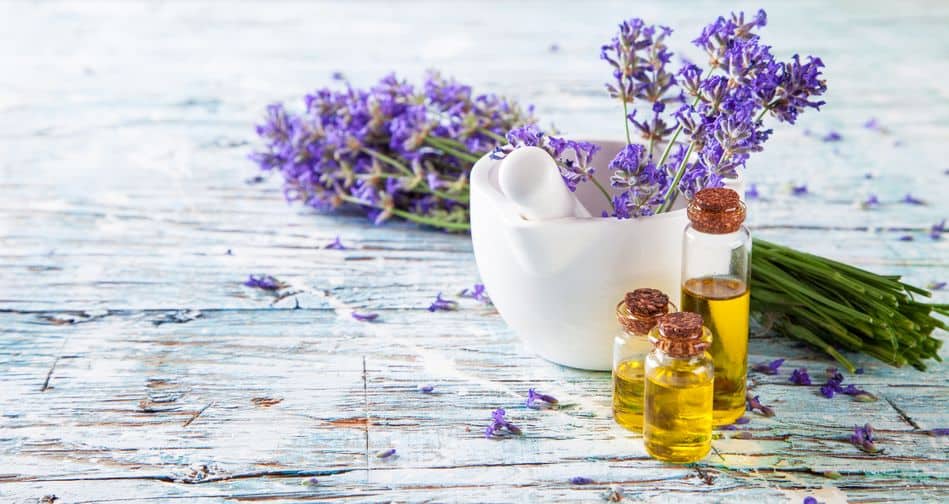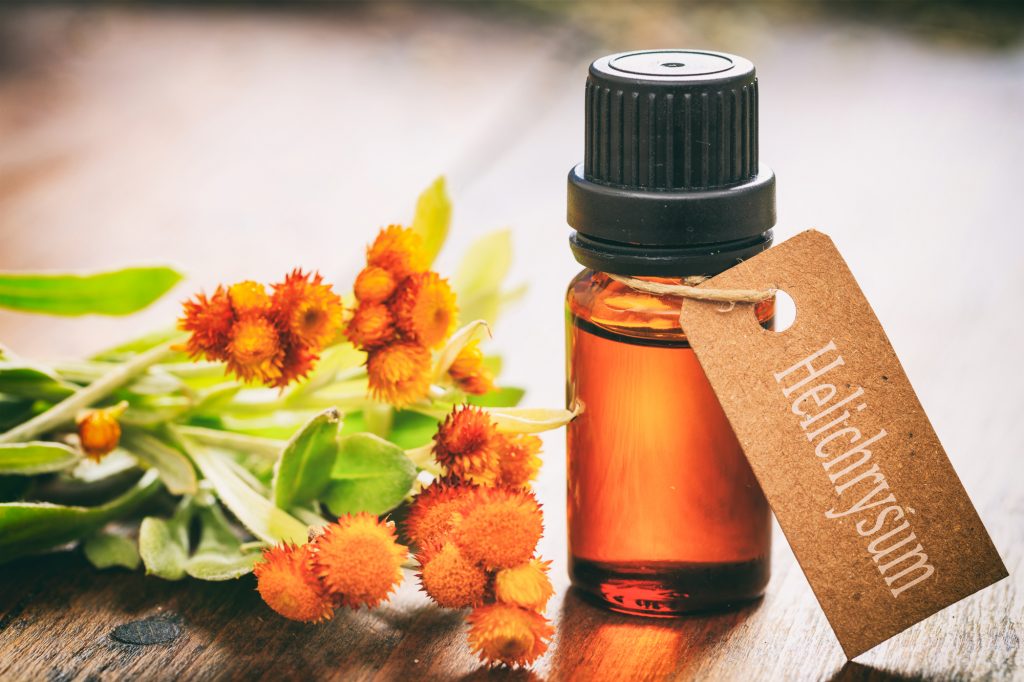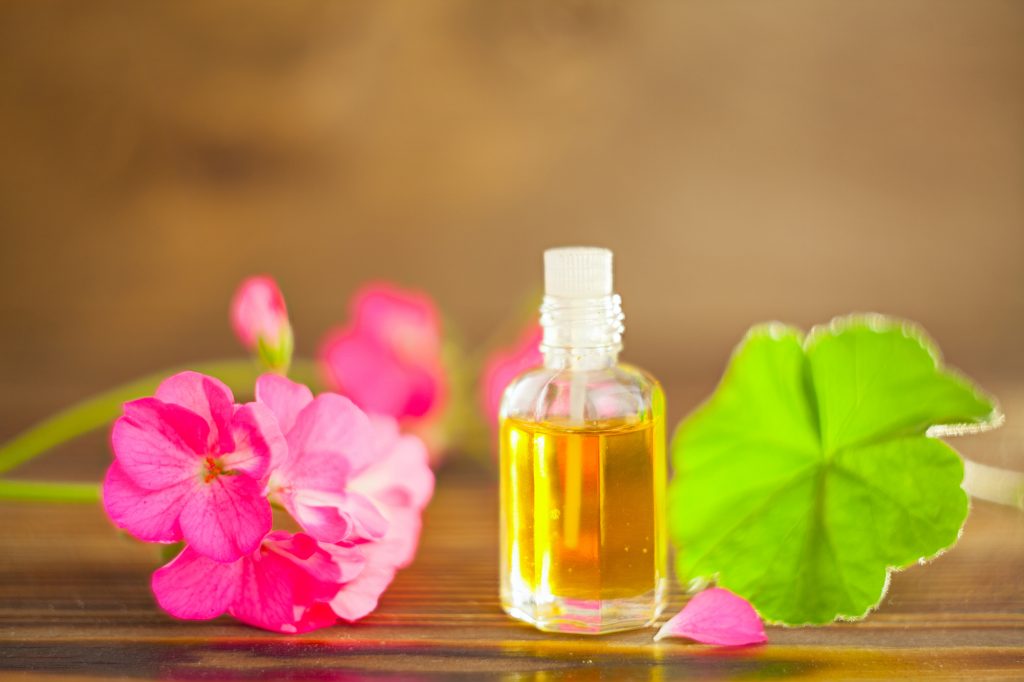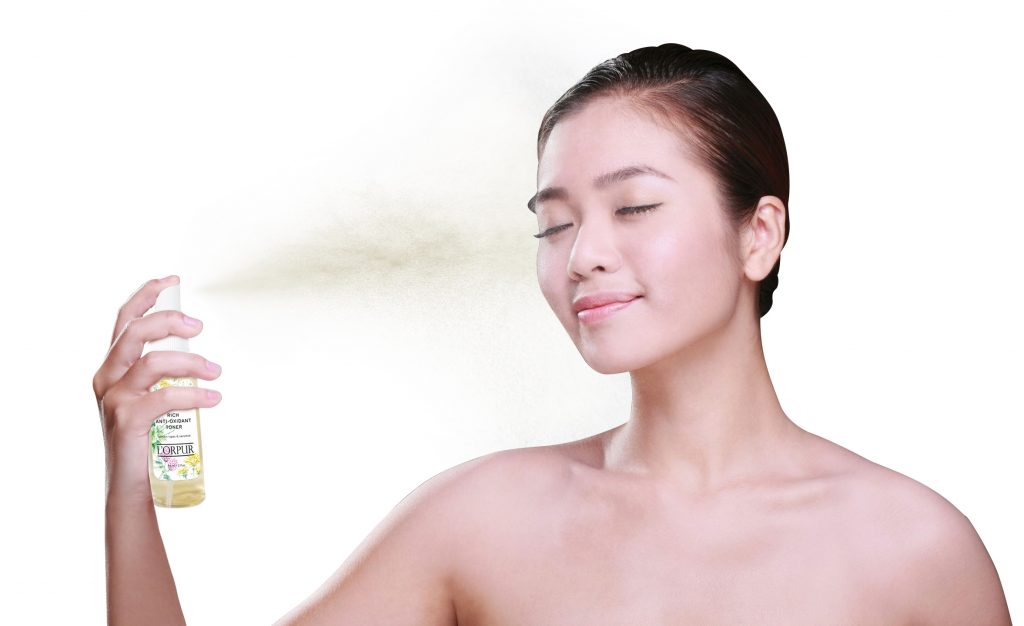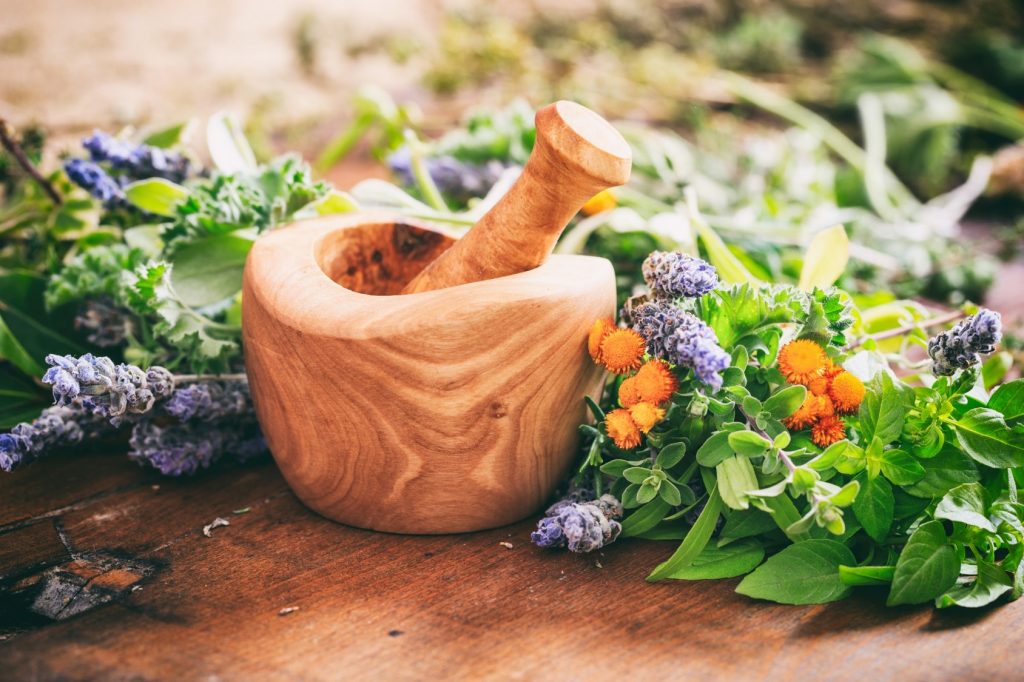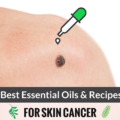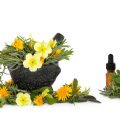The month of April is designated by the National Rosacea Society (NRS) as Rosacea Awareness Month. NRS’s aim is to educate about the impact of this common skin condition that causes redness and pus-filled bumps on the face and affects more than 16 million Americans.
Rosacea is a persistent and often complicated disorder of the skin that is becoming more common as more people are getting into the most vulnerable age range. It is usually indicated by flare-ups and remissions.
Often known as adult acne, rosacea generally appears after the age of 30 as inflammation around the cheeks, nose, face or brow that could appear and vanish. In some instances, rosacea might also happen around the chest, neck, ears or scalp. With time, the redness becomes ruddier and much more persistent, with blood vessels becoming noticeable.
Left without treatment, rosacea might give rise to bumps and acne. In serious cases the nose might get inflamed, become reddened and enlarged due to the extra skin cell tissue. In other cases, your vision will be affected. In short, rosacea is a skin condition that can seriously impair quality of life.
The goal of any kind of rosacea treatment is to reduce the presence of unsightly flare-ups. Although there’s no medically recognized cure for rosacea, the triggers that aggravate conditions like rosacea could easily be avoided with few lifestyle changes and the adoption of the right skincare program.
Generally addressed with the use of antibiotics, symptoms of rosacea may also be eased with the help of natural treatments. With their antimicrobial and anti-inflammatory properties, essential oils can significantly reduce the signs and symptoms of rosacea flare-ups including swelling, inflammation, and itching.
The Signs And Symptoms Of Rosacea
If you are above the age of 30 and often left red faced for no apparent reason, chances are that rosacea is trying to edge its way into your life. Frequent flushing accompanied by a feeling of your skin heating up or a distinct burning/stinging sensation are usually the early signs of rosacea.
In fact, if this happens often enough, it is time to stop dismissing these symptoms as a newfound sense of abashment and seriously ponder over the possibility of rosacea, because leaving this ailment to its own means is an open invitation to trouble.
The red of rosacea sure isn’t the worst of it!
Unfortunately, for everybody who suffers from rosacea, the persistent blush is just the start of their problems. With time, other equally visible and vexing symptoms come to the fore such as:
1. Skin thickening
Aside from persistent redness, this is another early sign of rosacea. The chronic inflammation of rosacea along with the neurovascular abnormalities not only put the sebaceous glands out of whack but also impact cellular regeneration rates.
So, the skin appears swollen, thick and waxy. The skin thickening usually starts and is most severe in the center of the face, affecting the forehead, the nose and the chin. But in some cases, it may spread to the cheeks, the eyelids and even both ears.
2. Pus filled, acne-like bumps
These may look like zits but the lesions are brought on by the anomalies of rosacea, so there is no involvement of blackheads. The bumps can be red and hard or pus filled. Because it is inflammation and not excess sebum secretion that leads to these blemishes, the skin may feel tight and the bumps may be painful to touch.
3. Swelling
Think of rosacea as an ongoing attack on your skin, and any body part that takes so much beating is bound to show overt signs of damage and inflammation. On rosacea afflicted skin, this is seen in the form of swelling, hive-like raised patches and scaling. The swelling or edema is caused by the accumulation of fluids in the dermal cells and layers and is a sign of more trouble on the way.
4. Stinging and burning pain
Even when there are no visible bumps/pimples, the redness of rosacea may be accompanied by a distinct burning/stinging sensation. Patients often compare the discomfort to that of a sunburn, but this one does not go away in a matter of hours or days.
5. Intense dryness or oiliness
There is a 50-50 divide when it comes to this symptom of rosacea. Nearly one half of all sufferers report struggling with excess oiliness, particular on and around the nose. The other half complain of extreme dryness in the center of the face, coupled with flaking and crusting. Rosacea, on its own, may not cause oiliness or dryness but it can exacerbate an existing problem.
6. Conspicuous blood vessel swelling and damage
The condition also leads to the appearance of thin, wiry, purple/reddish marks on the face. These are broken/damaged/swollen capillaries that have formed blood clots or are leaking fluids into the surrounding tissue.
7. Eye problems
A severe form of the condition, ocular rosacea leads to swelling and inflammation as well as the appearance of bumps and sties on the eyelids. Like with other rosacea afflicted areas, the blood vessels serving the eye area become inflamed and swollen.
This makes the capillaries on the eyelids and in the eyes appear more conspicuous and gives the eyes a bloodshot look. The skin around the eyelids may become scaly and crusty. The irritation can cause eye itching and watering and if not treated aggressively can cause vision loss. Did you know that a tea tree oil scrub is very effective in improving / eliminating ocular Demodex.
8. Nose disfigurement
Phymatous rosacea is an advanced form of the condition and one that is progressively disfiguring. It leads to excessive accumulation of connective tissue, skin thickening and irregular surface nodularities.
Although these changes can also occur on the chin, the forehead and the ears, they are most common on the nose. Known as rhinophyma, this form of rosacea causes bumpy growths around the nose, which give the nose a bulbous and disfigured appearance. Rhinophyma is more common in men than in women. In severe cases, the disfigurement can constrict breathing.
Although the symptoms of rosacea are typically restricted to the facial area, in some cases, the inflammation can spread downward to the neck and upward to the scalp. The ears are also often affected.
Facts About Rosacea
The two images below show 12 facts about rosacea.
Types Of Rosacea
Depending on the common symptoms, rosacea is classified into four subtypes. Each also presents the progression of the ailment from stage 1 to stage 4. Some patients may experience multiple subtypes of the condition across the affected areas.
Stage 1 – Erythematotelangiectatic rosacea
This is usually the initial presentation of the ailment, and it involves neurovascular abnormalities. The blood vessels swell up and become more visible and the skin takes on a persistent redness. More than 35% patients report suffering from a burning/stinging sensation.
Stage 2 – Papulopustular rosacea
Apart from redness and swelling, patients also develop acne-like papules and pustules. The blemishes are not always persistent and can come and go based on the severity of the other symptoms.
Stage 3 – Phymatous rosacea
Persistent swelling causes the skin to thicken, which leads to a bumpy texture and disfigurement.
Stage 4 – Ocular rosacea
The eyes are affected in this form of the condition. The ocular irritation mimics that of conjunctivitis and often it looks like the person has developed a sty.
Long term use of steroids is also known to cause rosacea in some patients. Steroid rosacea causes permanent redness on the cheeks and in the center of the face. The inflammation and redness do not go away even after the medication is stopped.
What Causes Rosacea?
Little is known about the precise cause/causes of rosacea. However, advances in medical sciences have allowed researchers to identify factors that play a role in the presentation of the ailment. Recent studies have revealed that the condition is possibly a continuum of a more widespread (systemic) inflammation, which may find its starting point in neurovascular and immune system anomalies.
It is not clear which comes first – the erythema or the hyper immune-inflammatory response. However, they have found a few factors that seem to be present in most rosacea patients:
1. Mast cells (MC)
These cells are responsible for innate immune responses that include inflammation. As you may have guessed, there are too many of these cells in the dermis and connective tissue of those who suffer from rosacea.
2. Cathelicidins
These are antimicrobial polypeptides responsible for the activation of the inflammatory action of MCs. As expected, more than the required amount of cathelicidins is found in the epidermis of rosacea patients.
3. Neuronal dysfunction and release of certain pituitary neuropeptides
Facial flushing that is often a precursor for rosacea inflammation is caused by neuronal dysfunction and the release of PACAP (a neuropeptide) that leads to the inflammatory response of MCs.
4. Demodex folliculorum
These are microscopic dermal mites that live in the hair follicles and feed on sebum. In regular folks, they don’t cause trouble but are implicated in instances of acne rosacea and blepharitis. The critters love areas of the skin where they have ample supply of food (sebum), so they can be found in high numbers around the nose, chin, forehead and the cheeks.
Researchers have not yet figured out if the germs trigger the innate immune response that eventually leads to rosacea inflammation or if the excess sebum secretion caused by rosacea allows the mites to thrive.
5. H. pylori
This bacteria is found in the gut and not on the skin. But, it is known to play a role in the hyper secretion of a tiny protein that causes vasodilation. Since vascular malfunction is usually a trigger in rosacea patients, the presence of these critters is suggested as a possible cause of rosacea.
In addition to these primary elements, several risk factors also play a role in the development of rosacea. These include:
- Light skin color, which increases susceptibility to photodamage.
- Genetic factors that may be responsible for the higher than normal number of mast cells.
- Skin irritation or injury that disturbs the endoplasmic network of the skin cells and triggers chemical reactions that lead to rosacea inflammation.
Because neuronal abnormalities are involved in the rosacea equation, it is normal for people who suffer from the condition to be overly sensitive to temperature, chemical and mechanical changes. So, several normally innocuous factors can prove to be triggers for those who suffer from the rosacea. Most common among these are:
- Stimulants like caffeine and alcohol that cause vasodilation
- Spicy foods that increase blood pressure and circulation
- Extreme changes in temperature
- Hot beverages that increase body temperature or blood circulation
- Exposure to wind, sunlight and humidity
- Vigorous exercise that increases blood pressure and circulation
- Hypertension
- Medical conditions that cause fever or inflammatory responses in the body like cold, flu and others
- Stress, anger, embarrassment and anxiety and other emotional states and mental conditions that impact the vascular system
- Steroids and drugs used to treat hypertension
- Hot showers, baths and saunas
When To See Your Doctor?
Because the symptoms of rosacea can overlap with those of other health problems, it is best to seek medical help for a proper diagnosis as soon as the symptoms present themselves. Moreover, you should also see your doctor if:
- Your rosacea symptoms seem to be worsening
- Pustules and red bumps have started appearing on the affected parts
- You have visible blood vessels (like spider veins) on your face
- The symptoms are causing eye irritation and vision problems
- The skin seems swollen and thick
- The symptoms are taking a toll on your mental health and confidence level
- Your nose seems to be taking all the heat of rosacea and often appears swollen and red
How To Get Rid Of Rosacea Permanently?
Let’s get one thing straight – There is no magic bullet when it comes to rosacea. This is a chronic ailment, which means that you will have an ongoing battle on your hands if you suffer from it. At this point, there is no known cure for rosacea.
But, it is possible to rein in the primary cause of the condition as well as the triggers. At the least, this approach will help to lower the frequency and the intensity of rosacea flare-up and at best, it can offer long lasting and possibly even permanent relief from the condition.
1. Controlling the causes
Since inflammation is at the core of this condition, the last thing you want to do is to add to your body’s penchant for hyper aggressive immune responses. The simplest yet most effective way to keep that immune system calm is to limit systemic inflammation. Fortunately, even small lifestyle and dietary changes can create a big splash on this front.
2. Avoid the triggers
This is a two-step process that involves identifying the triggers that lead to flare-ups and then avoiding them as much as possible or at least limiting the damage that these triggers can cause with preemptive countering. For example, if sun exposure turns you beet-red, be extra generous with your sunscreen use and once indoors, calm your skin down by applying some chilled aloe or flax seed gel to the affected parts.
Recommended Natural Products For Rosacea Skin
1. Amoils H-Rosacea
With H-Rosacea, you will be able to achieve a blemish free skin in the most natural way possible. I did it, and so can you! It is gentle on the skin and neither irritates nor scars. Click here to read my detailed review on Amoils H-Rosacea.
2. L’orpur Problem Skin Natural Cream
The L’orpur Problem Skin Relief Natural Cream is designed to treat and prevent recurrence of difficult skin conditions including rosacea. It has unmatched anti-bacterial and healing properties and provides instant and long-lasting relief for redness, dry / oily / itchy / scaling skin, rashes, swollen blood vessels, and acne-like breakouts.
What Are The Best Essential Oils To Use For Rosacea Treatment?
Here are my best essential oil picks for the treatment of rosacea:
1. German Chamomile
German Chamomile oil is produced from steam distillation or solvent extraction of the flower heads of the Matricaria Chamomilla plant. Its main component, chamazulene is known for its ability to reduce inflammation. Chamomile Oil doesn’t only calm the skin, it boosts the development of skin cells, and repairs damaged skin.
Its anti-inflammatory, antiseptic, anti-bacterial and fungicidal properties makes German chamomile oil beneficial for the treatment of rosacea. Further, it soothes and calms the skin, helps skin cell regrowth and heals damaged parts of the skin.
Here is an interesting story of a woman whose doctor told her that her rosacea was “incurable” and how she managed to eliminiate all symptoms of rosacea within six months of using a chamomile tea toner.
2. Tea Tree
The multi-pronged action of this oil is just what rosacea prone skin needs. Some consider this aromatic extract too strong for the inflammatory condition. But take a close look at the therapeutic benefits of tea tree oil and you will know that it is the perfect answer for all rosacea related woes. It all starts with the fantastic antimicrobial and anti-inflammatory properties of this oil that allow you to say goodbye to the redness and swelling of rosacea.
Then, there is the astringent effect of the oil, which is super effective against oiliness, waxiness and enlarged pores. If that is not enough, this oil is a critter-killer like no other. So, it not only eliminates demodex mites but also helps to deal with the pustules and papules that crop up because of rosacea.
Plus, tea tree oil can be used in multiple ways; from steaming to topical application and from cleansing to spot treatment, you can use this oil in and with any skincare formulation.
3. Lavender
While being a favorite essential oil for all types of skin, lavender is especially beneficial for skin conditions such as psoriasis, athlete’s foot, shingles, eczema and rosacea flare-ups.
When applied topically, lavender essential oil has anti-inflammatory effects that help provide relief to the pain and inflamed skin. It is also widely used for its therapeutic and curative properties ranging from relaxation to treating bug bites and from skincare to dealing with anxiety disorders.
4. Frankincense
This oil has held its own for millennia and continues to rule the world of aromatherapy all thanks to its superlative anti-inflammatory properties. A powerful healer, frankincense oil helps to soothe the damage and the discomfort caused by rosacea.
It is a potent immune modulator that regulates several inflammation-related signaling pathways, thus controlling inflammation before it turns into a problem. Moreover, the oil also boasts of astringent properties that help to regulate sebum production and pore size.
5. Helichrysum
Helichrysum oil (also known as Immortelle) has potent anti-inflammatory and anti-oxidant properties able to provide skin relief to a multitude of skin conditions including rosacea. This oil can handle the two major causes of rosacea inflammation – the demodex mites and the bacteria H. pylori.
Helichrysum is rich in ketones and beta-diketones, elements that promote the growth of new skin tissues and heals damaged skin. It is also gentle on the skin and when blended with German chamomile oil, its the perfect combo for skin rashes.
6. Sandalwood
Another cooling and soothing oil that helps to heal the distressed mind and skin, sandalwood oil is often used in dermatology to treat inflammatory skin conditions. Its intense calming effect helps to tackle the redness and the swelling caused by rosacea. Furthermore, the oil helps to deal with the swelling and inflammation of the blood vessels, helping to make them less conspicuous and reducing the damage caused by vascular abnormalities.
The aromatic extract is also an effective antimicrobial agent that works against skin mites and secondary bacterial infections that cause acne rosacea. People who suffer from the condition often report long remission periods following the consistent use of the oil. For best results, use sandalwood with turmeric essential oil, which is another powerful anti-inflammatory compound.
7. Cypress
A 2017 study showed that cypress essential oil had soothing properties that helps calm inflamed skin, reduce redness and promote fast skin healing, making it one of the best essential oils for the treatment of rosacea. Being an astringent, it provides antibacterial support to the skin and strengthens the skin tissue.
In addition, cypress oil has been used since ancient times for wound healing. Its skin-stimulating properties make it an excellent aid for firming and tightening loose, sagging skin in conditions like cellulite.
8. Rose geranium
This sweet-smelling oil not only handles the inflammatory aspects of rosacea but also deals with the swelling caused by the accumulation of lymphatic fluids. Additionally, if stress acts as a trigger for your rosacea flare-ups, the soothing nature of this aromatic extract will calm those frayed nerves and the itchy, stinging redness of your skin.
Like the others in this list, rose geranium essential oil has impressive antiseptic and antimicrobial properties that help to prevent secondary infections. Geranium oil is a gentle cleanser that regulates sebum secretion without drying the skin out. So, it reins in oiliness, flaking and rosacea acne all at once.
Some Pros And Cons Of Using Essential Oils For Rosacea Treatment
Pros:
- Unlike the medicinal approach, use of essential oils doesn’t have any side effects.
- Apart from being beneficial for rosacea, essential oils positively affect your overall health and keep you fresh throughout the day.
Cons:
- Some essential oil blends may not be suitable for those that have sensitive skin. Always make sure that you do a test patch before applying any essential oils to your skin.
- If you are already suffering from a medical condition like epilepsy or asthma, some oils may aggravate the condition and make it more prevalent.
5 Essential Oil Recipes For Rosacea
Recipe 1: Chamomile and Helichrysum blend (for sensitive skin)
I would recommend you go with this recipe if you have sensitive skin.
Ingredients:
- 1 oz. (30 ml) Tamanu oil (carrier)
- 8 drop German chamomile
- 10 drops Helichrysum
Directions:
Mix the oils together and store in small dark glass bottle, away from sunlight. Shake well before use.
Application:
Gently apply this blend to the affected areas on your face, i.e. don’t rub. Apply 3 times a day for a period of one week, then reduce the frequency to two times per day in the second week then once every day in the third week. This blend allows your skin to calm down whilst minimizing soreness and redness.
Now, there are a few options as to how to apply the blend. Many people use it under their moisturizer, some use it over it, and there are others who mix it with the moisturizer. You may also wish to add 1 tsp of aloe-vera gel to the blend.
Recipe 2: A potent / effective recipe (for non-sensitive skin)
Ingredients:
- 1 oz. (30 ml) Castor oil (carrier)
- 6 drops Tea Tree
- 4 drop Cypress
- 10 drops Rose Geranium
Directions:
Mix all the oils together well and store in small dark glass bottle in a cool dry place. Use same procedure as described in Recipe 1 above.
Recipe 3: Essential oil based face cream
Ingredients:
- 1 tsp emulsifying wax
- 50 ml Calendula hydrosol
- 1 tsp vegetable glycerin
- 2 oz (60 ml) Avocado or Rosehip seed oil
- 3 capsules Vitamin E
- 6 drops Helichrysum
- 8 drops Frankincense
- 12 drops Sandalwood
- 15 drops Lemon
Method of Preparation:
Stir the glycerin, the emulsifying wax, and the avocado or rosehip seed oil together in a double boiler on low heat. Wait until the wax completely melts, remove the heat source before adding the Vitamin E. Gently warm the hydrosol separately until it’s lukewarm. This is important if the hydrosol you have has been stored in the fridge, otherwise it won’t mix well.
Add hydrosol gradually into the mixture while stirring continuously until it’s thick and smooth. Then, add in all the essential oils. Your face cream is ready. Now, make sure that the cream is kept in a clean, sanitized jar. Give it time to cool down and put the lid on. Apply to the affected areas twice daily. Repeat until the swollen red bumps, flaking dry skin and falre-ups on your face has subsided.
Recipe 4: A cooling toner to calm the redness and rash
Ingredients:
- 7 drops Lavender
- 5 drops Tea Tree
- 8 drops Rosemary
- 6 drops German chamomile
- 1/2 oz. (15 ml) Apple Cider Vinegar
- 1 oz (30 ml) Aloe Vera gel
Directions:
Mix the aloe vera gel, apple cider vinegar and essential oils and mix thoroughly. Pour the mixture in a glass spray bottle and use on the affected areas of your face up to twice daily. Shake the bottle well before use and ensure that the blend does not get into your eyes.
Keep this anti-inflammatory, cooling spritzer while you are out in the sun. This could be helpful in reducing the flare-ups and redness associated with rosacea.
In the above recipe, apple cider vinegar acts as a toner to keep the skin’s natural acid layer in balance while aloe vera gel has firming and cooling effects on the skin.
Recipe 5: 28-day Rosacea Treatment Plan
Following is a 28 day treatment plan to follow. The plan is divided into two stages with each stage taking fourteen days to complete.

Stage One – First 14 days
Day Treatment
- 1 oz. (30 ml) Castor oil
- 5 drops Parsley (or Coriander)
- 10 drops German Chamomile
Gently apply 4-5 drops of this mixture daily to the impacted areas. Wait for a few minutes and allow the oil to soak into the skin; gently remove any excess oil using a tissue.
Night Treatment
- 1 oz. (30 ml) Sea Buckthorn oil
- 5 drops German Chamomile
- 8 drops Neroli
- 7 drops Sandalwood
At night, after cleansing your skin, apply 5-6 drops of this blend over the face. Avoid using any other cream, lotion, or product.
Stage Two – Last 14 days
Day Treatment
- 1 oz. (30 ml) Borage oil
- 9 drops Tea Tree
- 7 drops Cypress
Follow the same day time procedure as per the “first 14 days”.
Evening Treatment
- 1 oz. (30 ml) Evening Primrose oil
- 6 drops Frankincense
- 5 drops Lavender
- 8 drops Rose Geranium
Follow the same night time procedure as per the “first 14 days”.
Additional Tips:
Throughout these 28 days, get outdoors and enjoy the fresh air whenever you can. Increase your intake of fruits, vegetables, grains and fish. Use supplements to fulfill your body’s demands of Zinc and Vitamin B. Do not use any steam treatments or facemasks during this time. Avoid wearing makeup and stay well hydrated.
Do not use any harsh products on the face. To cleanse your face, use only a mild, gentle soap with tepid water, neither cold nor hot. In the final rinse, add two tsp of apple cider vinegar in the water and pat your skin dry.
Best 7 Carrier Oils For Rosacea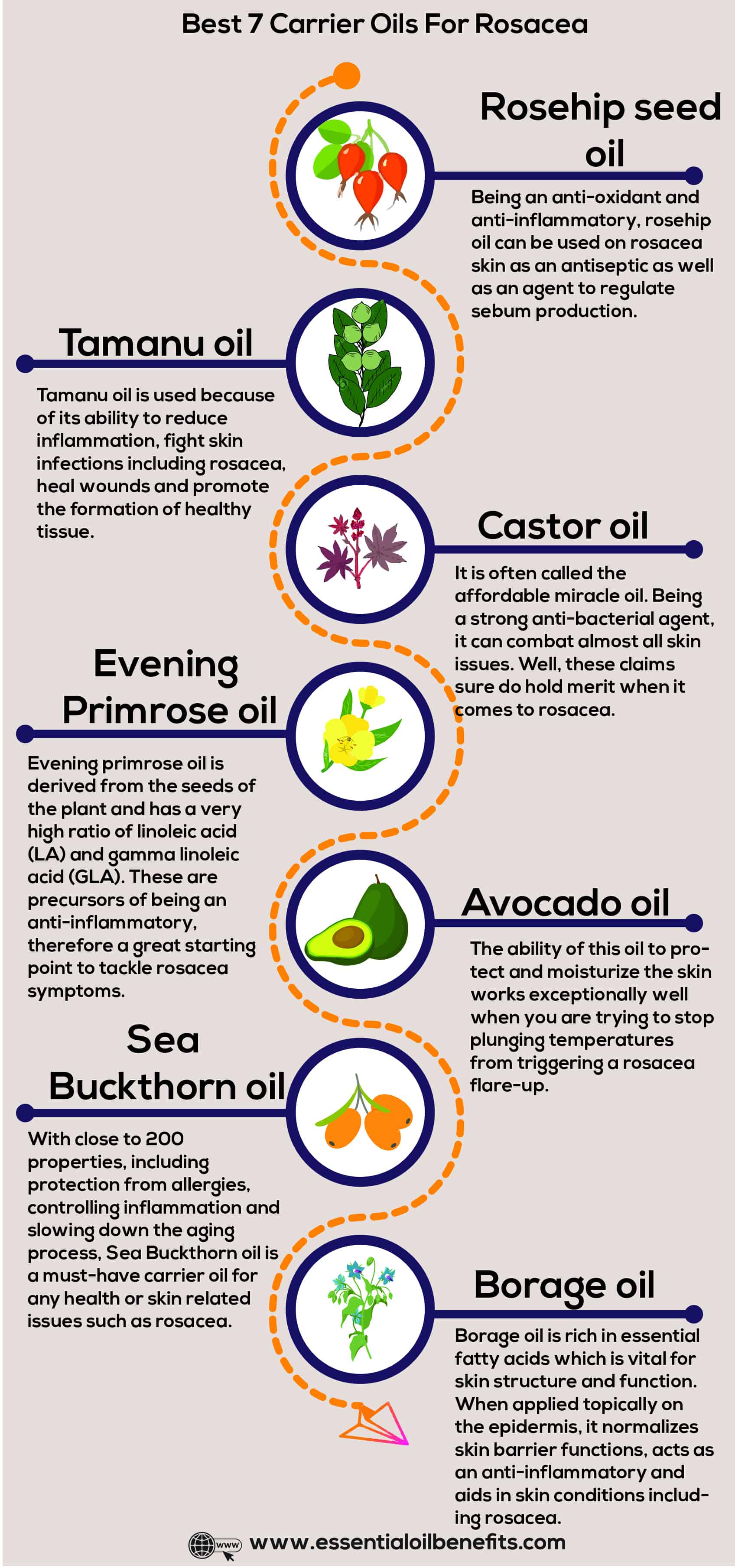
1. Rosehip seed oil
Rosehip seed oil features a high concentration of essential fatty acids which includes gamma linoleic acid (GLA). These acids are necessary for the formation and upkeep of healthy cellular membranes, through which nutrition passes into the cells. Being an anti-oxidant and anti-inflammatory, rosehip oil can be used on rosacea skin as an antiseptic as well as an agent to regulate sebum production.
2. Tamanu oil
Tamanu oil is used extensively in hospitals of Europe, Asia as well as the Pacific islands, because of its ability to reduce inflammation, fight skin infections including dermatitis, rosacea and others, heal wounds and promote the formation of healthy tissue. Studies have also confirmed its skin-active effects can help with conditions such as stretch marks.
3. Castor oil
It is often called the affordable miracle oil. Being a strong anti-bacterial agent, it can combat almost all skin issues. Well, these claims sure do hold merit when it comes to rosacea.
For starters, castor oil helps to hydrate and heal the skin without making it oily. Although it is a viscous carrier, its unique triglyceride blend makes it an effective astringent that helps to curb sebum secretion. It is often used in anti-aging products because it helps to tone and tighten the skin and shrinks the pores. Above all, castor oil helps to boost lymphatic drainage, which can help immensely when treating rosacea.
Edema or the accumulation of lymphatic fluids has been implicated in the progression of rosacea to its phymatous form. Because castor oil helps to remove the toxins and accumulated fluids from the dermal layers, it is remarkably effective in treating facial swelling and skin thickening.
If the oil is too drying or viscous for you, mix it with a nourishing and soothing carrier like hempseed oil to get all its therapeutic benefits without exacerbating flakiness. Usually, mixing castor and hempseed oil in 1:3 proportion works for all skin types.
4. Evening Primrose oil
Evening primrose oil is derived from the seeds of the plant and has a very high ratio of linoleic acid (LA) and gamma linoleic acid (GLA). These are precursors of being an anti-inflammatory, therefore a great starting point to tackle rosacea symptoms.
Evening primrose oil can be used both as a herbal supplement taken orally and as an oil for topical application. This oil allows the body to normalize the barrier functions of the skin and keep its cells properly hydrated while offering both astringent and soothing effects. It is also known to prevent xerotic cheilitis in acne patients.
5. Avocado oil
Given the viscous nature of this oil and the fact that the buttery green fruit is a trigger for rosacea in some people, the inclusion of this green oil may come as a surprise. But the shock only lasts till you take a look at its nutrient profile. Apart from its impressive medley of soothing and healing triglycerides, this oil also contains carotenoids and chlorophylls (only in cold pressed and unrefined oil), which can help to limit rosacea linked inflammation and skin swelling.
The ability of this oil to protect and moisturize the skin works exceptionally well when you are trying to stop plunging temperatures from triggering a rosacea flare-up. Moreover, avocado oil proves to be an excellent carrier in rosacea blends because it gets absorbed quickly and penetrates deep into the skin. Mixing it with jojoba oil in 1:1 proportion will help to get the therapeutic benefits of both carriers while lowering the viscosity of avocado oil.
6. Sea Buckthorn oil
With close to 200 properties, including protection from allergies, controlling inflammation and slowing down the aging process, Sea Buckthorn oil is a must-have carrier oil for any health or skin related issues. Its high content of unsaturated fatty acids, Vitamins A and E coupled with its anti-oxidant and anti-inflammatory properties makes it a superlative oil for rosacea skin.
7. Borage oil
Borage oil is produced from the seeds of the plant borago officinalis. It is rich in essential fatty acids which is vital for skin structure and function. The gamma-linolenic acid (GLA) in borage oil helps with its therapeutic properties.
When applied topically on the epidermis, it normalizes skin barrier functions, acts as an anti-inflammatory and aids in skin conditions including atopic dermatitis, seborrheic dermatitis and rosacea.
Natural Treatment For Rosacea
As mentioned above, it is best to talk to your medical practitioner about your rosacea just in case of an underlying condition, however if your rosacea is mild, you can try a few natural remedies.
Just a bit of chilling
The soothing goodness of aloe vera gel is legendary and if you have ever used the gooey ingredient on a burn wound, sun burn or rash, you may already know about its lightning fast effect on pain, burning, itching and inflammation. Well, the therapeutic effects of the gel are just as effective on the symptoms of rosacea.
In fact, if you add flax seed gel and green tea to aloe vera gel, you can get faster and longer lasting relief. You will need 1 tsp flax seed meal and ½ tsp matcha. Soak the flax seed meal in 2-3 tbsp of water and as soon as the powder takes on a gelatinous appearance, add 2 tbsp aloe gel and matcha to it.
Apply on red and inflamed skin and allow the mix of natural ingredients to work its magic for 15-20 minutes. Wash off with cold water and moisturize lightly. For best results chill the mixture for about 10 minutes before application. You want it to be slightly chilled but not freezing cold.
Cukes to nuke out rosacea
If you can feel a flare-up coming on, control the irritation and inflammation by using cucumbers. Use a peeler to cut thin strips of cucumber. Place these on the inflamed area, covering the redness completely. To stop the cuke strips from going dry before they chase away the redness and itching/burning, cover them with damp muslin/gauze strips.
Rosacea-specific skin care
If you suffer from rosacea, your skincare mantra should be “as gentle as possible”. So, chuck the loofah, facecloth as well as abrasive exfoliating scrubs in favor of a mild, soap free cleanser. Do not use any products with ingredients that can cause irritation or dryness such as alpha hydroxy acids, glycolic acid, alcohol, menthol, artificial colors and fragrances.
Also, avoid ingredients that cause burning, stinging, peeling, tingling or warming. This, pretty much, puts all strong essential oils out of bounds, such as those of cinnamon, thyme, oregano and others. Anti-acne products that contain salicylic acid as well as cleansers and soaps that have surfactants are simply too strong for rosacea skin and should be avoided. Have you tried the L’orpur soap – if not, it is gentle enough and well suited for rosacea.
It’s safest to opt for simple, all-natural products with no more than 1 or 2 active ingredients. Ensure that the ingredients are suitable for use on sensitive skin. Often formulations meant for babies and young children work well for rosacea sufferers.
Only use tepid water for washing your face and don’t cleanse your face more than once a day. In fact, I strongly recommend a shift to oil cleansing. Always pat your skin dry instead of wiping it and use a moisturizer meant for sensitive skin or a light or medium viscous carrier oil with anti-inflammatory essential oils added to it.
The healing effect of herbs
A lot of herbs offer intense anti-inflammatory effects when applied topically. The best part is that most of these are easy to find and use. Take your pick from green tea (matcha), licorice, feverfew, coriander/parsley and turmeric.
To use these, simply mix a heaped teaspoon of the herb (1/4 tsp if using turmeric) with coconut/almond milk to make a thick paste and apply on the affected parts. Don’t let the mask dry on your skin. Keep it on for 15 minutes and then wash off gently without a lot of rubbing and scrubbing. Remember to use tepid/room temperature water to remove the mask.
Whole body anti-inflammatory effect
When you are fighting rosacea, you need to wage the battle both on the inside and the outside. And when you need anti-inflammatory action inside your body, nothing works better than herbal infusions/teas.
Enjoy the healing and restorative benefits of Echinacea, turmeric, lavender, chamomile, basil, lemongrass and fennel by using them to brew deliciously flavorful and fragrant infusion teas. Just remember to wait till the brew cools to a luke warm before sipping on it.
You can also use these herbs to make iced teas. Instead of regular black tea, use green tea and add your chosen herb along with a dash of lemon juice/a few slices of your favorite fruit and some raw honey to make a lip smacking beverage that will heal your body from the inside out.
Lifestyle Changes To Manage Rosacea
So, here we are talking about steps to take to manage rosacea by reducing flare-ups as much as possible.
Caffeine and stimulants
Alcohol, coffee and even black tea can spell trouble for rosacea patients. While alcohol has its own problem creating pathway for rosacea, coffee and black tea create an issue only because of their caffeine content. So, go de-caf with your cuppa and opt for green, white and infusion teas. You may also want to consider chicory beans as a possible alternative for coffee.
Smoking
If you are suffering from rosacea, you are already fighting a war with widespread inflammation, so why would you want to add toxins to the mix and send the inflammatory response of your body through the roof? Every time you puff on a cigarette, you are literally pushing carcinogenic toxins into your lungs and from there into your blood stream, and more inflammation is not what you need when you are dealing with rosacea.
Cortisol control
Short of an act that causes actual physical injury, there is nothing out there that can do your body as much harm as stress. Think of any ailment that involves a faulty or hyper immune response and you will find stress as a likely cause. As far as rosacea goes, stress is one of the most common triggers for the condition.
So, work on your stress control process. Consider hobbies and activities that are known stress busters like yoga, tai chi, meditation and others. Also, get your 7-8 hours of sleep because the lack of zzz’s can quickly send cortisol levels soaring.
Stop sun damage
If you have a family history of rosacea or suffer from the condition, protecting your skin from physical insults is of paramount importance. Be it acne or harsh cosmetic treatments or sun exposure, your skin cannot afford damage. So, use a sunscreen whenever you head out. Instead of a chemical product, choose a formulation that contains zinc oxide and apply it over a moisturizer that can prevent the dryness caused by the mineral.
Go natural with your makeup
A lot of people use makeup to hide the symptoms of rosacea. Unfortunately, if you don’t pick the right products, the cosmetic formulations meant to mask the redness can actually end up exacerbating the inflammation. As far as possible, choose natural products that do not contain artificial fragrances and colors. Also, remember to keep your makeup routine simple, which means reducing the number of products that you use. The best way to do this is to choose multi-functional products; for instance, a tinted primer/base that also offers UVA/UVB protection.
Don’t turn into a couch potato
Yes, exercise is a common rosacea trigger, with more than half of all rosacea patients complaining of increased redness after a workout session. But, let us not forget that rosacea sufferers are at a greater risk of developing other inflammatory and immune system ailments.
So, keeping yourself fit is crucial. Plus, physical activity can go a long way in lowering stress. So, a sedentary lifestyle isn’t the right choice. A better approach is to opt for a rosacea-specific workout regimen.
Choose low to medium intensity exercises and only work out for 15 minutes at a time. So, instead of one long 45 minute session, go for 3 sessions of 15 minutes each at different times of the day. Also, work out in an air conditioned environment or when it is cool outside.
Supplements for healthy skin
Vitamin A, D, E and K along with B-complex vitamins and omega 3 fatty acids help to reduce inflammation. So, using a high quality supplement that contains these nutrients will certainly help. Probiotics can also prove to be effective as they help to keep the gut healthy.
Rosacea Diet – Foods To Eat & To Avoid
If you suffer from rosacea, the first thing you have to do is maintain a journal of triggers. In some people the triggers are hard to miss but in others it can take a while to figure out the foods that are causing trouble. Once you know about the triggers, it gets easier to stay away from them.
As far as general dietary habits go, play it safe and stop or at least reduce the intake of inflammatory foods such as dairy, sugar, refined flour, processed foods, fried food, products that contain chemical preservatives and hydrogenated oils. Also, do away with known allergens and food items that can trigger erythema.
Foods to avoid:
- Capsaicin containing ingredients like peppers and spices
- Foods that contain cinnamaldehyde like tomato, chocolate and citrus fruits
- Nuts (if you are allergic to them)
- Shell fish
- Spicy condiments like hot sauce
- Red meat
Foods to eat:
- Low sugar fruits like berries and melons
- Non-warming spices like cumin, coriander, fennel and cardamom
- Cooling and alkaline vegetables like kale, cruciferous veggies, celery, zucchini, lettuce, cucumber, pumpkin, squash, asparagus, sweet potatoes, leafy greens and okra, etc.
- Lean white meat (turkey or chicken)
- Goat cheese, fermented soya products
- Prebiotics, probiotics and fiber rich foods
- Chia, wild salmon and flax seed for their Omega 3 fatty acid content
The Final Word
Rosacea patients need not worry about the signs and symptoms of this unsightly skin disease as the techniques mentioned above can offer relief in shortest possible time. The major benefit of using essential oils for skin diseases including rosacea is that the treatment approach is all-natural. Unlike regular medicines meant for Rosacea, the use of essential oils has no side effects, offering patients an easy approach to overcoming the disease and a disease free life.

